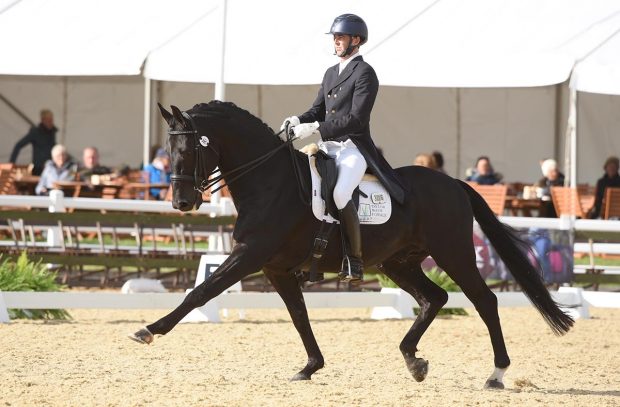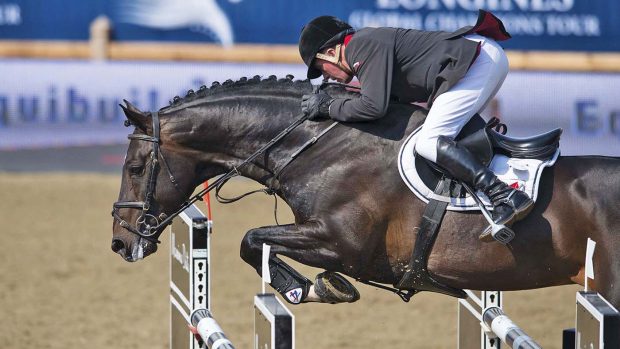It’s not news for me to say that Britain is somewhat lagging behind when it comes to sport horse breeding. Look to the likes of Holland with their well-established, well-integrated KWPN studbook or to Germany with its many prestigious books. Each has its breeding goals. And the government’s involvement in the sector gives a further, significant leg-up.
So it was partly marvellous and partly a bit depressing seeing the Andreas Helgstrand-owned stallions (pictured) put so many dressage sires in the UK into the shade at the BEF stallion show on Saturday (9 January).
The encouraging side of the coin is this: in order for British sport horse breeders to improve their stock, they need access to world-class stallions such as these. They visited; people saw them and can use them on their mares. Tick.
But what those stallions also did was to make it painfully apparent that many of the licensed stallions standing in Britain — particularly those graded here — are just not a patch on those long-legged supermodels who visited from Denmark.
Even horses who are no doubt kings of their domains looked somewhat lacking.
Of course not everyone is aiming to breed a 17hh dressage horse, but you get my point.
It’s hard being a stallion owner in Britain. And even harder to breed and own licensed stallions. Aiming to produce stallions who will stand up to comparisons with their continental counterparts — as Lynne Crowden of Woodlander Stud does — is an absolute mountain to climb.
We simply aren’t producing the number of quality foals necessary to be able to be ultra-selective about those which go on to grade. And our passporting and grading system is so tragically fragmented that a stallion can do the merry-go-round of British gradings until one studbook finally gives him the nod. Future breeders probably won’t even ever know about the rejections as studbooks are all hugely reluctant to release full data; the best we can usually hope for at the moment is a list of stallions who did make the cut. Where’s the transparency?
The ‘Carsten special’
Breeding great horses is one thing. Producing them is a whole different kettle of fish.
One of the things I always look forward to at the stallion show — which suited its new home of Bury Farm in Buckinghamshire well — is what Lynne refers to as “Carsten specials”.
Woodlander’s rider, an affable, craggy German of well over 6ft called Carsten Sandrock, shows stallions who are rising three-years-old — this year horses born in 2013 — under saddle.
Some of them haven’t been sat on more than half a dozen times and they aren’t amped up to trot round like auction freaks, rather Carsten allows them to wobble and bounce about in the unfamiliar surroundings, showing their natural gaits.
It’s a real skill of his, and he always does it with a smile on his face. Somewhat alarmingly he never uses a neck strap, but at least these days he always wears a helmet.
More harm that good?
Some other stallion presentations probably did the horses more harm than good in the public’s perception.
It’s not enough to plan, nurture, breed and grade a stallion. He also needs a good rider to show him off.
The show is, afterall, a rare shop window opportunity to showcase the horse in front of a new audience.
Alas, in a few instances, the riders were simply not up to that job, and made the stallions — and in certain cases their progeny — look anything but rideable.
Nerves took over for some, too, and horses were ragged round the ring at 100 miles an hour.
Owners need to make more clinical, objective decisions about who is best matched to show off their breeding stallions on the day. Nobody wants to be the talk of the show when the chatter is only about how badly ridden the stallion was.
Of course some presentations were harmonious and a pleasure to watch.
Seeing the palomino Dimaggio son Treliver Decanter back from injury and running through all the grand prix movements was ace. And Catherston Springsteen — although an old-fashioned stamp of a horse — was naughty and boisterous for rider Lizzie Murray. He’s 19 now, and still fit and sound, and I love that “Bruce” hasn’t lost any of his sense of humour. And Bobby Hayler gave Woodlander Wavavoom an exemplary ride.
We’re so lucky to have this parade and thanks must go to organisers Jan Rogers and Cat Wood for their tireless work and refreshing positivity.
But the quality of some of the stallions risks making British breeding look bad.
We have a collective responsibility to up our game. You’d never see riding with bouncing, hard hands and nagging ineffective legs at the best stallion shows, and nobody wants to see it here either. It certainly wouldn’t be rewarded in a competitive sphere.
Of course copying everything the best shows do isn’t for us either — we need to be selective and carve out a British identity for the show. British and professional. Not British and “oh it was ok and everyone tried really hard so please don’t criticise”.
More competing stallions, please
Might discounts for competing stallions be available to encourage top riders to bring the best we have to the show? And how about getting British Dressage, British Showjumping band British Eventing involved? The least they could do would be to help spread the word about the show, but they could be far more actively involved, drawing on the engagement of their tens of thousands of members. This show should be standing room only!
Lets take steps to improve things by first being honest with ourselves.
See you next year.
Alice




